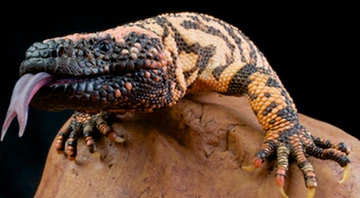The Gila monster and the closely related Mexican beaded lizard are the only known medically important lizards in the world.

These heavy-bodied lizards are easily distinguished from nonvenomous species by the bead-like surface and yellow or coral colored pattern of their skin. They are described as shy and retiring reptiles, not prone to attacking humans unless they are significantly agitated. Arizona laws protect these fascinating animals from being captured or held in any manner.
These large reptiles have a well-deserved reputation for clamping down on a victim with their teeth and not letting go. Most serious bites occur when the Gila monster's lower jaws secure a firm hold on the victim that lasts for several minutes.
The bite is described as extremely painful, although initial pain is generally confined to the area of the bite. Victims may also experience localized swelling, nausea, vomiting, high blood pressure, weakness, faintness, excessive perspiration, chills and fever. Some people have experienced severe reactions resulting in breathing difficulties.
What to do if bitten
If you are bitten, it is important to remove the lizard as soon as possible. One of the more practical ways to do this is to pry open the lizard's mouth with a strong stick--but be sure to allow the lizard a solid foothold on the ground while you are trying to pry it off.
First aid in the field may include
- irrigating the wound with plenty of water
- immobilizing the affected limb at heart level,
- reassuring the patient.
Call 1-800-222-1222. All patients with a Gila monster bite who call the poison center are referred to a medical facility.
There, the wound should be carefully explored for broken teeth. It is important to ensure that tetanus immunization is up-to-date and that the patient is observed for signs and symptoms of infection.
There is no antivenom available for the treatment of a Gila monster bite.

